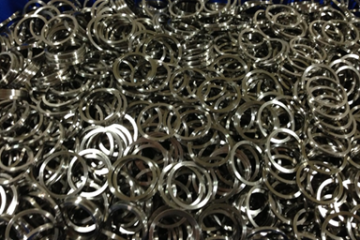What is Gold Plating?
Gold plating is the process of adding a layer of gold to a metal. This is accomplished both chemically and electrically. By applying a direct electric current to another layer of metal, and applying the gold coating, it creates a chemical bond between the two metals, fusing them together.
The layer of a gold coating is very thin, usually in the range of 0.0002 inches. Adding a layer of gold plating to metal has many uses, among them are protection from rust, corrosion or damage.
Industrial gold plating companies do large volumes of parts and orders. They do not do gold plating for decorative uses or for single items.
Frequently there will be several layers of different metal plating, all used for specific purposes.

The Gold Plating Process
The first step in gold plating is preparing the surface of the metal. The surface must be very clean in order to not have a smudged or dirty look on the finished product. It is also important because impurities can make the gold plating does not adhere to the underlying surface. We use acid baths to make sure the surfaces are free of all impurities before we move to the next step.
Next we do a rinse with purified water to make sure all the cleaning agents and acids have been removed.
Typically, the next step is to add a thin layer of nickel as this improves the bond between the gold and whatever is beneath it.
Then once again the product is rinsed to make sure there is nothing between the middle layer(s) and the final gold plating.
After the final rinse, the piece to be plated is submerged into a solution that is carefully set to the proper temperature and has the proper voltage running through it to get the gold ions to bond to it. The temperature and voltage are set depending on the substrate metal and the desired thickness or use of the finished product.
Uses of Gold Plating
Gold plating is used in a variety of beneficial ways including:
- Medical use: Gold is biocompatible meaning it is not harmful to living tissue and is actually resistant to germs. Implanted devices such as stents and joints as well as dental implants frequently have an outer layer of gold therefore.
- Durability: Gold is a strong metal and an electroplated gold can make the surface more resistant to dings and generally hold up better with wear and tear.
- Corrosive-proof: Gold plating provides excellent corrosion protection as it is the metal that reacts least to corrosion – it does not react with oxygen to produce rust. It therefore is a good coating to use in corrosive environments.
- Conductivity: Gold is an excellent conductive material and is frequently used in situations where an electrical current is needed and, as mentioned above, is in a corrosive environment..
Advanced Surface Technologies offers a variety of plating solutions, including gold plating. Contact us for your plating needs today.
